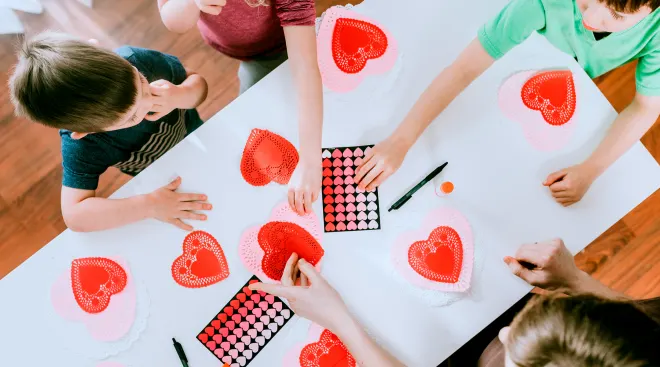How Open-Ended Pretend Play Benefits Kids
Childhood play elicits images of tiny tots “making breakfast” in a play kitchen, hosting tea parties with all their stuffed animal friends or having long conversations with “Grandma” on their banana phone. All three of these scenarios fall under open-ended play, which is important for a child’s learning and development. There are many types of open-ended play, including symbolic play, imaginative play and pretend play. But exactly what does each entail? And how do these similar but different types of play benefit children? Keep reading to learn how to foster creativity and encourage these imagination-boosting activities.
Open-ended play is exactly what it sounds like: Children are “free to imagine anything they want,” and come up with their own play structure, explains Cindy Hovington, PhD, founder of Curious Neuron, a science-backed parenting consultancy. There are several types of open-ended play, including fantasy, imaginative, pretend, make-believe, outdoor, sensory, constructive and symbolic play. Each is slightly different and nuanced—and experts have varying definitions for each. “It depends on who you ask,” Hovington says. That said, many types of open-ended play are used interchangeably, says Maria Shaheen, PhD, senior director of early education at Primrose Schools, as they all involve imagination, role play and creativity. Below, experts offer a closer look at three similar types of open-ended play.
Pretend play
Pretend play occurs when kids act out different scenarios and role-play things they’ve witnessed while out and about in the world, Hovington explains. While these scenarios are “pretend,” they do tend to draw upon real-life experiences. Some pretend play examples include:
- Pretending to go to the library, grocery store, cafe, zoo or bank with caregivers
- Acting out working at a restaurant, pretending to be the chef or server (or both!), and using different objects to represent food (this ties into symbolic play, listed below)
- Pretending to be a doctor and acting out a scenario in which a patient is in for their checkup
- Pretending to be people familiar to the child, like their parents or teachers
Imaginative play
Imaginative play incorporates pretend play, but leans into a child’s imagination and creativity. “Although you’re still pretending to be someone or something, it may not be a specific role,” Hovington says. “You might be a two-headed monster, a unicorn, a dog that hops like a kangaroo, etc.” In other words, while imaginative play involves playing pretend, it also incorporates completely fictionalized scenarios and characters that wouldn’t appear in our world. An example of imaginative play could be a tea party your little one throws, but they invite a friendly dragon, an elephant and several of their stuffed animals friends, who all talk to each other and drink tea together.
Symbolic play
Symbolic play is another type of open-ended play where a child “uses objects to symbolize something else,” Hovington says. For example, they may use the TV remote as a cellphone, a basket as a hat or an empty cardboard box as a car or a boat. You’ll see symbolic play used in both pretend, imaginative and many other types of open-ended play.
Shaheen says that kids began to use objects to represent other things (symbolic play) as early as 12 months, but Hovington points to 18 months as the age when kids naturally start to pretend play. “They naturally want to mimic what they see and are interested in the items they see their parents or caregivers using (i.e the remote control),” Hovington says.
Beyond the toddler years, imaginative and pretend play peak in preschool, Shaheen says. “As children mature, their pretend play grows in complexity and can occur without tangible objects. For example, during older preschool years (ages 4 to 5), children begin to engage in socio-dramatic play and create their own themes and storylines, lessening their need for concrete objects to serve as part of the pretend play,” she adds. For example, a group of children might pretend they live in a castle and assign each other roles, such as knights, horses, princes and princesses.
This stage of imaginative and pretend play can last well into childhood, until 7 or 8 years of age—and even into adulthood. “Recent research has demonstrated that imagination and playfulness can help adults improve cognitive skills, creativity and innovation in the workspace, so pretend play has opportunities to help people grow throughout adulthood,” Shaheen adds.
“Play helps to increase neural connections in the brain, which is critical in the first five years of development,” Shaheen says. And there are several benefits of symbolic, imaginative and pretend play in particular, as they help improve overall cognition and behavior. Below, the key benefits of symbolic, imaginative and pretend play:
-
Supports communication development: Some studies suggest that, imaginative and pretend play help early language development. Plus, it also improves communication skills, as kids learn to talk to their friends, how to take turns, when to step back and work together to build play scenarios, Shaheen and Hovington both note.
-
Improves socio-emotional skills and regulation: Pretend play offers little ones a positive and safe environment to “deal with all their big feelings and gives them a chance to play-act emotions,” Shaheen says. “For example, children who are afraid of ‘monsters under the bed’ feel safe acting out monster scenarios through play where they’re in control.” Along with helping kids understand their own emotions and impulses, pretend and imaginative play also teaches them how their words and actions can affect others, Hovington adds.
-
Supports cognitive development: On a basic level, “playing pretend with their parents or friends means kids have to remember the roles they each have,” Hovington explains. “It also helps a child develop symbolic thinking, which helps them understand objects around them and how they’re used.” Along with these cognitive skills and the ones listed above, pretend and symbolic play also teach kids how to problem solve and help them gain confidence, Shaheen says. “As children’s cognitive skills grow, so does the complexity of their play.”
While toeing the line between letting your little one’s imagination run free and guiding their play, there are ways parents can encourage pretend, imaginative and symbolic play. Below, some tips:
-
Read to baby: Shaheen notes parents can introduce imaginary and pretend play scenarios right from infancy by reading together. “Children who are exposed to more books tend to engage in richer play scenarios due to their wider familiarity with more types of characters, plots and themes,” she explains. As your child grows, Hovington adds that parents can also “recreate some children’s books and TV shows” and cites Bluey as “a great show for young kids filled with pretend play ideas.”
-
Provide different types of play materials: Shaheen says providing a variety of play materials that are developmentally appropriate can be very helpful as children grow through different stages of play. Hovington agrees, adding that, around the age of 12 months, parents can also start to introduce pretend play concepts, for example through toys like kitchen sets and play food. But don’t worry about buying elaborate toys—while those are great, objects found at home like wooden kitchenware, whisks, spatulas, note pads, markers, rulers, clothes for dress-up, etc. also suffice as tools to encourage play, she adds.
-
Model symbolic, imaginative and pretend play: For babies and young toddlers, the experts recommend modeling different ways of utilizing objects, using an empty plastic or wooden kitchen bowl and spoon, and asking baby to “bake a cake” together. “As the child gets closer to 18 months, they’ll initiate pretend play on their own a lot more and need less guidance from their parents,” Hovington adds.
-
Create stories together: “Make up stories together while traveling in the car or at bedtime,” Shaheen suggests. “This helps increase imagination and creativity.” You can even do this during chores to make them more fun and interactive, like using socks for puppets while folding the laundry together.
-
Lean on their interests: As your child becomes a preschooler, Hovington recommends finding out what they’re interested in and leaning into those activities. For example, if they really enjoy going to school, set up the living room as a school, and have your child role-play being the teacher while you pretend to be the student.
-
Set up playdates: This is particularly important for preschoolers, who are in “the prime of their pretend play years,” Shaheen says. “Provide many opportunities for them to engage in play alone and with their friends.”
-
Limit electronics: While using devices every now and then is totally okay, Hovington recommends getting rid of them as much as possible when it comes to playtime.
-
Do things together. Shaheen recommends parents see the world through their tot’s eyes and fill their time with shared experiences, like trips to the museum, zoo, puppet show theater and more. After all, “children often represent their experiences in the world as they engage in pretend play,” she says.
If your kiddo isn’t showing interest in pretend or imaginative play by age 3, Hovington says to flag it to your pediatrician; it could potentially be a sign of autism or indicator of neurodivergency. A 2019 study found that children with autism spectrum disorder have a greater tendency to not engage in imaginative and pretend play. However, Hovington emphasizes that this isn’t the only sign of neurodivergency parents should look for, nor does it automatically signal a diagnosis.
“Since children develop at different rates, it’s always important to consider early indicators with a note of caution and gather information over time, in conjunction with pediatricians, psychologists and other experts, before jumping to conclusions,” Shaheen says. Moreover, if your child is on the spectrum, she adds that “there are strategies to help children with autism learn to engage in pretend play (or mimic characteristics of pretend play).”
Imaginative, symbolic and pretend play are all important for child development, as they build numerous cognitive, social and emotional skills. The best way to encourage them is to provide several types of play opportunities. “Take time to tap into your own inner child and simply enjoy following your child’s lead and engaging in their make-believe world,” Shaheen says. And if you’re concerned about your child’s play habits or overall development, don’t hesitate to reach out to your child’s pediatrician.
Please note: The Bump and the materials and information it contains are not intended to, and do not constitute, medical or other health advice or diagnosis and should not be used as such. You should always consult with a qualified physician or health professional about your specific circumstances.
Plus, more from The Bump:
Cindy Hovington, PhD, is the founder of Curious Neuron, a science-backed parenting consultancy that aims to make the science around childhood development more accessible and digestible for parents. She’s also the host of the Curious Neuron podcast. She obtained her master’s degree from Queen’s University and a doctorate in neuroscience from McGill University, both located in Canada.
Maria Shaheen, PhD, is the senior director of early education at Primrose Schools and has over a decade of experience working as a teacher. She has a doctoral degree in curriculum and a master’s degree in elementary education, both from Kent State University, located in Ohio.
Journal of Education, Pretend Play and Early Language Development—Relationships and Impacts: A Comprehensive Literature Review, 2022
Neuropsychiatric Disease and Treatment, Prediction Of Playfulness By Pretend Play, Severity Of Autism Behaviors, And Verbal Comprehension In Children With Autism Spectrum Disorder, December 2022
Learn how we ensure the accuracy of our content through our editorial and medical review process.
Navigate forward to interact with the calendar and select a date. Press the question mark key to get the keyboard shortcuts for changing dates.





















































